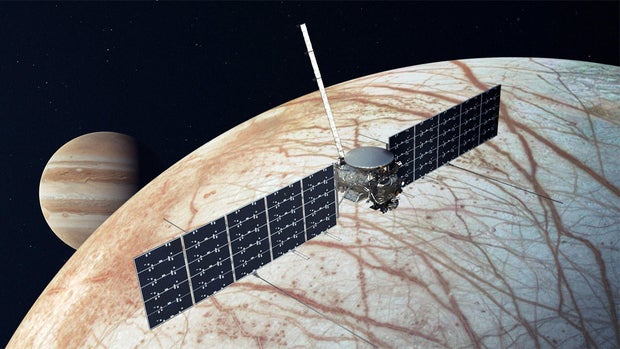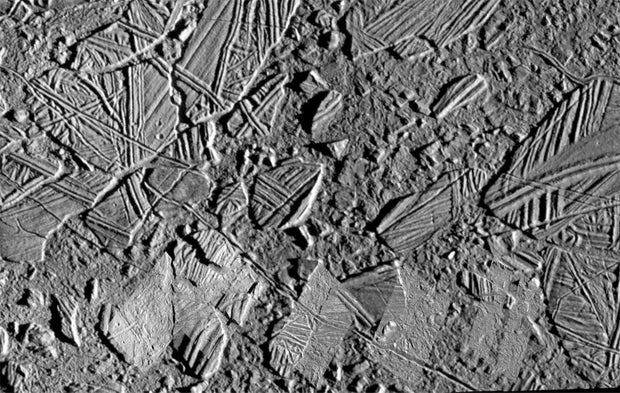After an exhaustive evaluation of suspect transistors in NASA’s Europa Clipper spacecraft, NASA managers have cleared the probe for launch subsequent month as deliberate on a $5.2 billion mission to search out out if a suspected sub-surface ocean on Jupiter’s icy moon Europa is a liveable surroundings.
The transistor subject cropped up in Could, elevating fears the scope of the Clipper’s mission might need to be diminished or the flight delayed for pricey repairs.
However the evaluation confirmed the transistors in query will, in impact, heal themselves through the 20 days between the excessive radiation doses the probe will obtain throughout every of 49 shut flybys of Europa, all of them deep in Jupiter’s highly effective magnetic discipline and radiation surroundings.
NASA
As well as, onboard heaters can be utilized as wanted to boost the temperature of affected transistors, enhancing the restoration course of.
“After intensive testing and evaluation of the transistors, the Europa Clipper mission and I personally have excessive confidence we are able to full the unique mission for exploring Europa as deliberate,” stated Jordan Evans, Europa Clipper mission supervisor at NASA’s Jet Propulsion Laboratory.
The solar-powered Europa Clipper, considered one of NASA’s most formidable planetary probes, is a “flagship” mission designed to make a number of shut flybys of Europa to study whether or not a subsurface salt water ocean beneath the frozen world’s icy crust may host a liveable surroundings.
If habitability may be confirmed, “simply consider what which means, that there are two locations in a single photo voltaic system which have all of the substances for all times which are liveable proper now on the similar time,” stated Curt Niebur, Europa Clipper program scientist at NASA Headquarters.
“Consider what which means if you prolong that consequence to the billions and billions of different photo voltaic techniques on this galaxy. Setting apart the ‘is there life?’ query on Europa, simply the habitability query in and of itself opens up an enormous new paradigm for looking for life within the galaxy.”
Found in 1610 by Galileo, Europa has been studied by NASA’s Voyager probes and, far more extensively, by the company’s aptly-named Galileo orbiter within the Nineties, which made a dozen shut flybys.
The spacecraft found that Jupiter’s magnetic discipline was disrupted round Europa, implying an electrically conductive fluid deep throughout the moon. Given Europa’s frozen crust, the more than likely rationalization is a sub-surface salt water ocean, stored heat by tidal flexing, the repetitive squeezing by Jupiter’s huge gravity because the moon swings by means of its orbit.
NASA
The Europa Clipper just isn’t designed to seek for indicators of life on or beneath Europa’s crust. However confirming the presence of a hidden sea and figuring out its habitability can be a serious step ahead within the seek for locations within the photo voltaic system and past the place life, as at the moment outlined, may exist.
“That is an epic mission,” Niebur stated. “It is an opportunity for us to discover not a world that may have been liveable billions of years in the past, however a world that may be liveable at this time, proper now,”
“An opportunity to do the primary exploration of this new sort of world that we have found very lately known as an ocean world, that’s simply completely immersed and coated in a liquid water ocean, fully not like something we have seen earlier than. That is what Europa Clipper and her group are going to unveil for us.”
Scheduled for launch from the Kennedy Area Heart on Oct. 10 atop a SpaceX Falcon Heavy rocket, the spacecraft will first fly previous Mars in February, utilizing the crimson planet’s gravity to ship it towards one other velocity-boosting flyby of Earth in December 2026.
Solely then will the Europa Clipper be touring quick sufficient to move out into deep house on a trajectory to Jupiter. Even so, the probe will not attain its goal till April 2030, utilizing its thrusters to brake into an preliminary orbit across the large planet.
5 months later, the primary in a sequence of shut flybys of a number of moons might be wanted to arrange the primary shut encounter with Europa within the spring of 2031. Throughout two science campaigns operating by means of 2034, not less than 49 shut flybys of Europa are deliberate, together with passes as little as 16 miles above the moon’s frozen floor.
The mission was progressing towards launch when engineers have been alerted in Could to a probably significant issue with transistors used all through the spacecraft. Related elements have been discovered to fail at decrease radiation doses than anticipated.
The radiation surroundings round Jupiter is powered by the planet’s titanic magnetic discipline, which traps and accelerates electrically charged particles from the photo voltaic wind and the volcanic moon Io. The radiation surroundings within the neighborhood of Europa would kill an unprotected astronaut in a matter of hours.
In consequence, Europa’s flight laptop and different key elements are protected in a radiation-resistant “vault.” Radiation “hardened” elements are used all through the spacecraft. However take a look at knowledge from the producer confirmed comparable elements have been failing at decrease radiation ranges than the Europa Clipper will expertise.
However after months of testing, engineers concluded the spacecraft can full its mission with no main modifications.
“We accomplished intensive testing to validate the transistors on the spacecraft,” Evans stated. “We ran assessments 24 hours a day during the last 4 months at a number of places. We simulated flight-like circumstances to light up any points that the transistors might need over our four-year science mission throughout the number of functions we’ve on the spacecraft.
“We put these consultant transistors into these environments, irradiated total circuits to see how the system behaves. … We replicated that transistor self-healing, or annealing because it’s known as, that happens by heating them to room temperature whereas they, primarily, (are out of) that intense radiation surroundings as we go round every orbit.”
Primarily based on the outcomes, he stated, “we’re prepared for our closing launch preparations and critiques. We’re prepared for Europa.”


